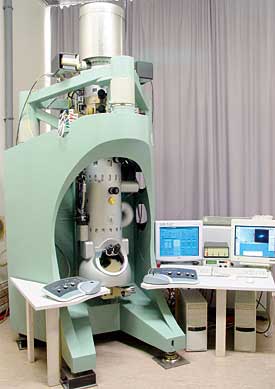| Posted: March 1, 2007 |
New unique TEM for high-resolution imaging of biomaterials |
|
(Nanowerk News) Together with researchers from the Max Planck Institute for Biophysics in Frankfurt, the Nano Technology Systems Division of Carl Zeiss SMT has developed a unique transmission electron microscope for the high-resolution phase contrast imaging of biologic materials. The PACEM system (Phase Contrast Aberration Corrected Electron Microscope) will enable artifact-free imaging of biologic specimens through the use of a unique phase plate and an aberration corrector, thus proving scientists unparalleled insights into the molecular and atomic structure of biologic processes and mechanisms of action. The development project is part of the Macromolecular Complexes cluster of excellence initiative and the introduction of elite universities in Germany.
|
 |
VA prototype of the PACEM system during assembly (Image: Carl Zeiss SMT AG)
|
|
Prof. Werner Kühlbrandt, Director of the Max Planck Institute for Biophysics and one of the coordinators of the Frankfurt cluster of excellence, considers this unique approach one of the most important and promising in the almost 70-year development history of electron microscopy. This project is intended to lead to the realization of the long-desired dream of electron microscopists for the artifact-free imaging of biologic specimens. After all, biologic specimens are actually invisible in an electron microscope. Image contrasts can only be generated by strongly defocusing the electron lenses. However, until now, this has led to unwanted artifacts in the image which severely affect the image information.
|
|
In the course of the latest advances in nanotechnology, it has become possible to transfer special phase contrast procedures used in light optics to electron microscopy. Additionally, an electrostatic micro-lens – the phase plate – is integrated into the focal plane of the microscope during the PACEM project. This makes the previously necessary defocusing of lenses obsolete and, in conjunction with an aberration corrector, significantly increases the focus of the image and the resolving power.
|
|
Dr. Rasmus Schröder, the leading developer of phase-plate microscopy at the Max Planck Institute for Biophysics in Frankfurt, is convinced that artifact- free images of biologic specimens can be achieved for the first time in the history of electron microscopy through the use of a phase plate.
|
|
The German Federal Ministry of Education and Research is sponsoring Carl Zeiss SMT and its partner institutes in the implementation of this groundbreaking project for transmission electron microscopy.
|
|
|

